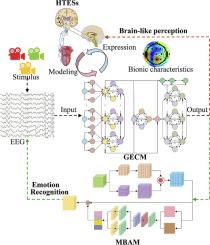基于脑电图神经传导机制的情绪识别:结合多块注意模块的味觉-情绪耦合模型
IF 7.5
1区 计算机科学
Q1 COMPUTER SCIENCE, ARTIFICIAL INTELLIGENCE
引用次数: 0
摘要
基于脑电图的情感识别通过对脑信号的解码,实现脑机融合中准确的情感交互,从而提高人机协作的智能化程度。数据增强(DA)技术为情感识别中数据稀缺性的挑战提供了一种有希望的解决方案。然而,传统的数据分析方法往往忽略了脑电数据背后的生理机制,限制了其有效性,制约了情绪分类的表现。为了解决这一问题,提出了一种基于人类神经传导机制(ncm)的味觉-情绪耦合模型和多块注意模块(GECM-MBAM),以提高情绪识别的性能。首先,脑电图刺激下的GECM输出再现了脑反应的1/f特征和同步。验证了该模型在脑电信号处理中的仿生学性能,显示了通过GECM对脑电信号的类脑感知。其次,根据GECM输出的特征设计MBAM,便于情绪相关脑电的数据增强。对比实验表明,GECM-MBAM在识别精度上显著优于多种现有的数据分析模型(p < 0.05),证实了其在脑电数据增强方面的有效性和优越性。最后,当与最先进的算法和消融研究相比较时,GECM-MBAM在情绪识别方面表现出优越的性能。具体而言,GECM-MBAM在SEED和SEED- iv数据集上的准确率分别为96.91%和94.52%,召回率分别为96.23%和93.86%,kappa系数分别为95.45%和94.29%。综上所述,GECM-MBAM提高了情感识别的性能,为情感计算提供了一种新的仿生处理方法。本文章由计算机程序翻译,如有差异,请以英文原文为准。

EEG-based emotion identification from nerve conduction mechanisms: A gustatory-emotion coupling model combined with multiblock attention module
Electroencephalogram (EEG)-based emotion identification enables accurate emotional interaction in brain-computer fusion by decoding brain signals, thereby enhancing the intelligence of human-computer collaboration. Data augmentation (DA) techniques offer a promising solution to the challenge of data scarcity in emotion identification. However, traditional DA methods often overlook the physiological mechanisms underlying EEG data, limiting their effectiveness and constraining the performance of emotion classification. To address this, a DA model based on human nerve conduction mechanisms (NCMs), named the gustatory-emotion coupling model and multiblock attention module (GECM-MBAM), is proposed to improve the performance of emotion identification. First, the 1/f characteristics and synchronization of brain responses are reproduced in the GECM output when stimulated by EEG. The bionic performance of the model in EEG processing is validated, demonstrating brain-like perception of EEG signals via the GECM. Second, the MBAM is designed based on the characteristics of the GECM output, facilitating data augmentation of emotion-related EEG. Comparative experiments demonstrate that GECM-MBAM remarkably outperforms multiple existing DA models in recognition accuracy (p < 0.05), confirming its effectiveness and superiority in EEG data augmentation. Finally, when compared with state-of-the-art algorithms and in ablation studies, GECM-MBAM demonstrates superior performance in emotion recognition. Specifically, GECM-MBAM attains accuracies of 96.91 % and 94.52 %, recalls of 96.23 % and 93.86 %, and kappa coefficients of 95.45 % and 94.29 % on the SEED and SEED-IV datasets, respectively. In conclusion, the performance of emotion identification is improved using the GECM-MBAM, offering a novel bionic processing approach for affective computing.
求助全文
通过发布文献求助,成功后即可免费获取论文全文。
去求助
来源期刊

Expert Systems with Applications
工程技术-工程:电子与电气
CiteScore
13.80
自引率
10.60%
发文量
2045
审稿时长
8.7 months
期刊介绍:
Expert Systems With Applications is an international journal dedicated to the exchange of information on expert and intelligent systems used globally in industry, government, and universities. The journal emphasizes original papers covering the design, development, testing, implementation, and management of these systems, offering practical guidelines. It spans various sectors such as finance, engineering, marketing, law, project management, information management, medicine, and more. The journal also welcomes papers on multi-agent systems, knowledge management, neural networks, knowledge discovery, data mining, and other related areas, excluding applications to military/defense systems.
 求助内容:
求助内容: 应助结果提醒方式:
应助结果提醒方式:


